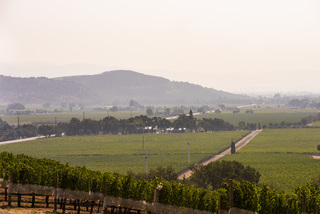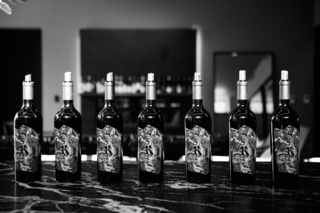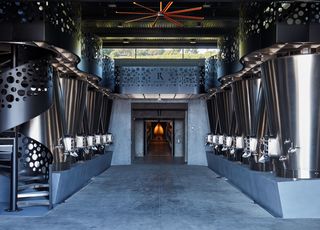Benoit: “2020 is a vintage that reminds us this is farming. This is agriculture. It is not for the faint of heart.”
In 2020, Napa Valley was on track for another great vintage. It was a drought year, but the vines were healthy and by early August, grape clusters were going through veraison, ready for the final stage of ripening. At Realm, we readied the Whiskey Hotel to receive its first grapes, excited for harvest and especially looking forward to bringing in fruit from our Estate vineyards. But Mother Nature had other plans. The LNU Fire, which started in Napa County as the Hennessy Fire and eventually encompassed neighboring counties, broke out in the early morning hours of Monday, August 17th, the result of a series of highly unusual thunderstorms and lightning strikes that pummelled Northern California over a 72-hour period.
If you’ve read Realm’s story about the fires of 2017, you know this felt like déjà vu for us. Thankfully, unlike 2017, we knew our winery wasn’t in danger of burning, nor were our Estate vineyards in the Stags Leap District or Coombsville. We didn’t have to jump into the high adrenaline, fight or flight mode that characterized ‘17. It was hot, really hot, but the winds weren’t blowing the flames our way. This fire seemed to spread more gradually, but it gained steam as it merged with fires in other counties. Within several days a blanket of smoke covered Napa Valley, cloaking everything, including the vineyards, in ash. It would stay that way for several more weeks.
Benoit had a sense right away what we might be dealing with. He knew from 2017 what smoke could do to grapes, and to wine. He began sampling vineyards immediately, sending the grapes to a local lab to be analyzed for smoke infiltration. The first results didn’t look so bad, but Benoit didn’t trust them. The lab in Napa, which would soon be inundated with grape samples from hundreds of wineries, only tested for two “markers” for smoke taint. From his research in 2017, Benoit knew there were other markers for smoke that could be measured. He continued to gather grape samples, both from our Estate and growers’ vineyards, and sent them to labs in Canada, France and eventually Australia, facilities which had the capability to test for these other markers. He also did a few small-scale fermentations and had those samples tested to see if the results were any different.
The next couple of weeks were agonizing. Lab results trickled in, and they started to form a grim picture. The levels of smoke infiltration seemed to be rising, but not always above what is considered the “threshold” of detection. As the days went by, we knew we had to make some decisions, particularly for our growers’ sakes. If we were going to refuse their fruit, we wanted to let them know ASAP, so they’d have a chance to sell it to another buyer. Benoit kept going back to 2017, to the wines he’d made from grapes we harvested post-fire, the wines we ended up de-classifying.
Benoit: “In 2017 we took and paid for all our growers’ post-fire fruit. And we made the wine, treating it just like the pre-fire fruit except for trials where we washed the grapes or treated them with ozone or fined the wines, etc. And when we did the blind tastings, comparing the pre-fire to the post-fire lots, it wasn’t even close. We could identify the post-fire lots every time, ten out of ten, twenty out of twenty. We’d gone all the way through the cycle and realized none of it was usable. We couldn't even take one barrel of the post-fire wine and use it to blend. So in 2020, as we tasted fruit and got lab results, our view pretty quickly became realistic about what we saw happening. As the days went by we realized the fruit wasn’t going to be usable. Regardless of what the lab results were, we knew we had to trust our own palates and experience. Absent better data, we had to go back to what we learned in 2017. We kept looking for other data points, to see if we were missing something. But in the end, we had to make the best-informed decision.”
Smoke taint, for those not familiar with it, is a tricky phenomenon. It’s not necessarily something you taste in the grapes, at least not early on when they’ve been exposed for just a few days. It’s a characteristic that becomes more obvious in the wine, post-fermentation. And while it can bring on a smoky taste to the wine, we think the flaw is as much textural as flavor or aroma-driven. It’s a dry harshness in the back of the palate, an echo chamber of sharp, smoky ash that ruins the finish. Once you recognize it, it’s unmistakable.
By mid-September, with thick smoke still hanging over the valley, we made the call. There would be no 2020 vintage at Realm Cellars. We did harvest our Estate fruit, using it mostly for experiments. We even made a little rosé, a first for Realm. But there will be no 2020 Single Vineyard Cabernets, no Proprietary Blends, no Moonracer or The Absurd. As hard as the decision was, it was also one of the easiest. It reminded us of the 2009 Bard, when we made the decision to pour it down the drain.
As discouraging lab results continued to come in, we called our growers to give them the news. Some of those calls went well, some not so much.
Scott: “The hardest conversations were with growers who seemed to have a different view of how the wine market works. We’re talking about the high end of wine growing, and we had a few conversations where the growers thought we could take the fruit and sell our wines at half the price. I understand the logic, and maybe that would work on a commercial level, where wine is more of a commercial beverage than a product of Mother Nature. But I think we need to treat our customers with reverence. I believe they look to us to be an arbiter of taste. We will never put wine in the bottle that's compromised. That is not the way we’ve built relationships and trust over time. When they see a bottle of Realm, they should trust it. That's the whole essence of the brand.”
By making this decision early, our hope was that most growers, at least those without crop insurance, would find another home for their fruit. Some did. And with many of our growers, the conversations were easier. They know Realm and understood our viewpoint immediately. Not only that, these growers understand farming. They know that every vintage is a gift; it’s never a guarantee. As we learned in 2017, you find out so much about a person’s character and outlook at a time like this. Nowadays, we are growers too, responsible for the fruit from our Stags Leap District Estate as well as the Farella Vineyard. We know first-hand the risks inherent in farming so in that sense we can empathize with the difficulty faced by each grower.
From our current vantage point, even just a matter of weeks removed from that fateful moment, we know we made the right call about 2020. Others may make different decisions about the vintage, and we can and should make allowances for the nuances and differences from one vineyard or one vintner to the next. Lab results have continued to come in (yes, the labs were that backed up), confirming what we suspected in mid-September. The markers continue to rise, particularly on the fermented samples we submitted, often well above the threshold of detectability. It doesn’t make us happy to see this, but it is vindication.
We’d be less than truthful if we said this wasn’t going to hurt. The loss of the 2020 vintage will have a multi-year impact on our business. Thankfully, we have two great vintages in the cellar, 2018 and 2019, both with larger volume. (Ironically, while we were deciding the fate of the 2020 vintage, we held our September release of the 2018 Proprietary Blends; it was one of our most successful offers to date.) We’ll get creative about the timing of construction; we’ll probably have to delay certain things. We’ll have to be a little scrappy, but we’re used to that. Certainly, we can take a financial hit now more easily than we could have in 2012, ‘13 or ‘14. At some point, scale becomes a friend because you have enough wherewithal to get through the leaner years. We just think it would be wrong and dangerous to make the 2020 wine, put it in the bottle and try to convince ourselves and our customers there's not a problem. We’re not riding on the edge that way anymore. We're way more resilient. Realm can take the punch. It's in our DNA.
Scott: “Realm is all or nothing. It's either we're aiming for the very best or we don't do it at all. And I love that strategy because I think that's why the wines are the way they are. We throw everything at it, including our heart and soul.”
An Addendum: The Glass Fire
The Glass Fire which erupted in Napa Valley on September 27th was smaller in acreage than the LNU Fire, but the devastation it did to homes, businesses, wineries, vineyards, and livelihoods here is nearly unfathomable. Realm was not in the pathway of destruction. But we know so many others affected by unimaginable loss, including many people and wineries with whom we’ve had formative relationships. Sherwin Family Vineyards on Spring Mountain, the winery where Realm made its very first vintage in 2002, was destroyed. Chateau Boswell, where we made wine from 2007 to 2015, also gone. In the early years we shared office space with Jeff Smith of Hourglass Vineyards, who lost his winery to the Glass Fire. As the tally of destruction kept rising, we couldn’t help but be humbled. And reminded again of how fragile life, and farming as a way of life, really is. For us, the fate of the 2020 vintage had already been sealed, but our loss pales in comparison to what others are experiencing. As we look ahead, we know Realm will be okay. Napa Valley has survived phylloxera, Prohibition, economic downturns, and now a global pandemic and devastating wildfires. This place will endure.



